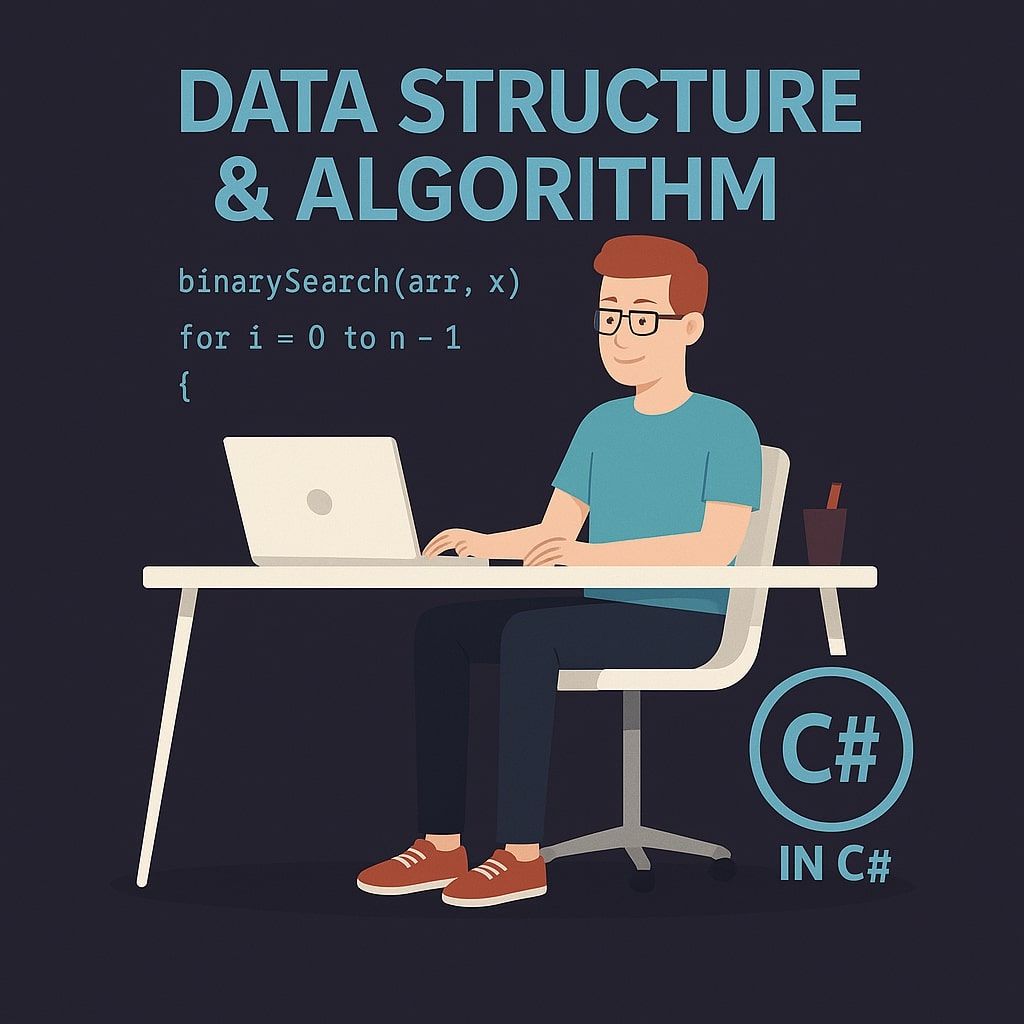In this era of technology, more and more data is being generated with each passing day. Therefore, knowing how to code is not enough. As the software applications scale, their complexity increases, and larger data volumes must be handled. The performance and efficiency of your application depend upon how you organize and manage that data. This is where data structures and algorithms come into play.
In this tutorial, we will learn how to implement data structures and algorithms in C# to handle data. Make sure to practice what you learn in this tutorial. Let’s start with an introduction to data structures and algorithms and set up the development environment to work with them.
What are Data Structures?
In programming, data structure is a way of storing and organizing data to make it more accessible and manageable. Consider it as a roadmap that shows how data is arranged in the memory. Data structures allow us to access, manage, retrieve, and perform other operations on data more effectively.
Consider looking for a pair of shoes in a shoe rack. If the shoes are scattered randomly, it will take you more time to locate the identical pair. On the other hand, finding the desired pair becomes easy if the shoes are arranged category-wise or in any other order. Similarly, selecting a data structure that fits your application’s needs is highly crucial for efficient data processing and enhanced performance.
You can find numerous real-world examples for how data structures work. For instance, a phone book organizes the entries alphabetically, books in a library are organized by author and category, songs are arranged in genres, and more.
What are Algorithms?
Algorithms are a step-by-step solution to a recurring problem. It helps you accomplish a certain task by sequentially resolving a problem. The algorithms are designed to take input from users, process it, and generate the desired results after going through a sequence of steps.
For instance, you follow a recipe when you have to cook something. You can call a recipe an algorithm that tells you how to achieve a desired result since it is a step-by-step demonstration of how to achieve a certain task. The algorithms provide the logic and a series of tasks required to manipulate the data stored in data structures.
Relationship Between Data Structures and Algorithms
The relationship between the data structures and algorithms is quite confusing. The algorithms perform actions on the data structures to perform a task efficiently. On the other hand, the type of data structure being used to store and handle data impacts the performance and efficiency of algorithms. The efficiency and performance of each is highly dependent on the other.
Why Data Structures and Algorithms?
Learning data structures and algorithms give you too many benefits in the long run, including but not limited to the following:
• Understanding data structures and algorithms helps you write functional, efficient, and memory-friendly code for large datasets.
• Learning DSA provides you with problem-solving skills and techniques that help you resolve complex problems like data organization and manipulation.
• DSA is one of the core topics that are included in technical interview questions. Having a deep understanding of DSA concepts can help you demonstrate problem-solving skills.
Common Data Structures and Algorithms
In your software engineering journey, you will come across numerous data structures and algorithms, the most common ones of which are given below:
• Arrays: A collection of homogeneous data elements.
• Linked Lists: Lists that are connected with pointers.
• Stacks: A Last-In-First-Out (LIFO) data structure.
• Queues: A First-In-First-Our (FIFO) data structure.
• Trees: A hierarchical data structure.
• Graphs: A structure that represents the relationship between objects.
• Sorting and Searching Algorithms: The sorting algorithms help organize data in a sorted manner, and the searching algorithm enables you to search data.
Setting Up Development Environment
You need a development environment to test the algorithms and data structures we learn in this tutorial. I personally prefer using Visual Studio, which provides you with all the tools you need to write, run, and debug your code. However, you can also use the .NET CLI (Command Line Interface), which requires you to write your code in a text editor and run it through CLI. You can use whatever you prefer. Just install it and get started with your C# journey. In this tutorial, I’ll be using Visual Studio so the instructions in this tutorial will be accordingly.
Creating and Writing Your First Program
Once you have successfully installed Visual Studio, it’s time to check if it’s working fine or not. To do so, launch Visual Studio and follow the steps below:
- Select Create a new project
.
- Type in Console in the search bar and select Console Application. Make sure it says C# and not Visual Basic. Hit Next.
- Now, in the next window, enter the name of your project. For instance, DataStructuresIntro.
- Select a location to save the project and click Next.
- In the Additional Information dialog, select the latest stable version of .NET Framework, select Do not use top-level statements, and click Create.
A new project will be created, and you will land on the welcome screen.
- Now, from the right navigation, double-click Program.cs file.
Some sample code will appear on the screen. Replace that code with the following:
using System;
namespace DataStructuresIntro
{
class Program
{
static void Main(string[] args)
{
Console.WriteLine("Introduction to Data Structures!");
Console.ReadKey();
}
}
}
To run this program in Visual Studio, either click on the Run button in the top ribbon or press CTRL + F5 keys simultaneously to run without debugging.
If the program runs successfully, it means that you have installed Visual Studio correctly. If not, you may have not installed the required dependencies and packages and may need to reinstall the program.
After ensuring that the Visual Studio works fine, continue to the next lesson, where I’ll introduce you to the Time Complexity and Big O Notation.
